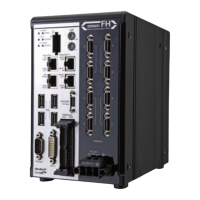Terminology
28
Vision System FH/FZ5 series Hardware Setup Manual (Z366)
Scene A unit for changing the measurement flow that consists of a combination of pro-
cessing items.
“Scene” is used because of the correspondence to the scene (i.e., type of measure-
ment object and inspection contents) where measurements are performed.
A scene is created for each measurement or measurement contents.
You can easily achieve a changeover simply by changing the scene when the mea-
surement object or inspection content changes.
Normally you can set up to 128 scenes. If you need more than 128 scenes, you can
separate them into different groups or use the Conversion Scene Group Data Tool
to create a scene
group that contains over 128 scenes.
processing unit (abbreviated as “unit”) A processing item that is registered in a scene.
Numbers are assigned to processing units in order from the top and they are exe-
cuted in that order.
Processing items are registered for the processing units to create a scene (i.e., a
unit for changing the measurement flow).
measurement trigger A trigger for executing measurements.
With a parallel interface, the STEP signal or command 00 (Continuous Measure-
ment) is used. With a serial interface, an Execute One Measurement or a Start
Continuous Measurement command is used.
test measurement A measurement that is performed to manually test (check) measurements under
the conditions that are set in the currently displayed scene.
Test measurements can be executed on an Adjustment Window. Processing is
completed inside the Controller and the measurement results are not normally out-
put on an external interface.
However, you can select [Output] in [Test measurement] to output the measure-
ment results after executing measurements.
single measurement A measurement that is executed only once in synchronization with the trigger input.
continuous measurement Measurements are executed repeatedly and automatically without a trigger input.
Operation mode Double Speed
Multi-input
A mode that processes the measurement flow for the first trigger and then pro-
cesses the measurement flow in parallel for the second trigger to achieve a
high-speed trigger input interval. It is used together with the multi-input function.
Multi-line ran-
dom-trigger mode
A trigger mode that allows you to independently processing multiple measurement
flows.
With traditional image processing, two or more triggers cannot be acknowledged at
the same time.
In Multi-line Random-trigger Mode, you can randomly input multiple triggers into
one Controller to independently process multiple scenes in parallel.
Non-stop adjust-
ment mode
A mode that allows you to adjust the flow and set parameters while performing
measurements.
The enables adjustments without stopping the line or stopping inspections.
Standard A logging mode that allows complete parallel processing of measurements and log-
ging.
Traditionally, logging was not possible while processing measurements. Either
measurements or logging had to be given priority and the other one had to wait.
With this mode, you can save the measurement images in external memory without
affecting the transaction time.
parallel processing (an option for any
of the above operation modes)
Parallel processing splits part of the measurement flow into two or more tasks, and
processes each task in parallel to shorten the transaction time.
Processing items for parallel processing are used so that the user can specify the
required parallel processing.
Term Definition

